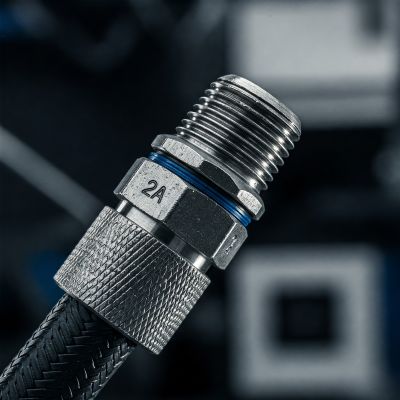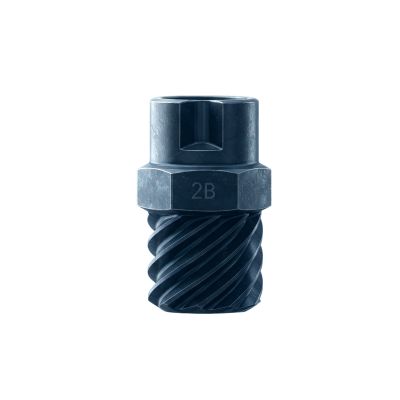Hydraulic threads play a crucial role in various industries, from aerospace to heavy machinery, ensuring secure and leak-free connections in hydraulic systems. Choosing the right thread type is essential for maintaining efficiency, durability, and performance.
Among the most commonly compared thread types are 2A and 2B threads. While they share similarities, their differences impact their usability in different applications. This post will help you understand the key distinctions between 2A and 2B threads and determine which one best suits your needs.
Understanding Hydraulic Threads
Hydraulic threads are specialized fasteners used in hydraulic systems to connect pipes, hoses, and fittings securely. Their design influences their ability to withstand high-pressure environments, maintain a tight seal, and support structural integrity.
Importance of Thread Design
➡️ Sealing Performance: Properly designed threads help prevent leaks and pressure losses.
➡️ Durability: Threads must withstand repeated assembly and disassembly without degrading.
➡️ Compatibility: Thread types need to fit industry standards for broad usability.
What Are 2A and 2B Threads?
2A Threads
2A threads are classified as external (male) threads with a looser tolerance. They allow for easier assembly and disassembly, making them suitable for applications that require frequent maintenance.
2A Thread Specifications
➡️ Moderate tolerance, allowing for better flexibility in fitting.
➡️ More clearance between the male and female parts.
➡️ Used in industrial and mechanical applications where ease of assembly is a priority.
Where 2A Threads Are Commonly Used
➡️ Automotive industry (e.g., bolt and nut fastenings).
➡️ General mechanical assemblies requiring easy removal and installation.
➡️ Construction machinery where moderate fit is sufficient.
2B Threads
2B threads are internal (female) threads that provide a tighter tolerance fit. They are preferred in applications where secure fastening and higher strength are needed.
2B Thread Specifications
➡️ Closer tolerance than 2A threads, providing a tighter fit.
➡️ Reduced clearance between the male and female threads.
➡️ Used in high-pressure applications where a strong seal is required.
Where 2B Threads Are Commonly Used
➡️ Hydraulic fittings and pressure-sensitive connections.
➡️ Aerospace and military applications requiring secure fastening.
➡️ Heavy-duty machinery where durability is critical.
Key Differences Between 2A and 2B Threads
Fit and Tolerance Levels
➡️ 2A Threads: Looser fit, allowing for easier assembly and disassembly.
➡️ 2B Threads: Tighter fit, ensuring a more secure connection.
Strength and Durability
➡️ 2A Threads: Offer moderate strength but allow for movement and adjustments.
➡️ 2B Threads: Higher load-bearing capacity due to tighter tolerances.
Sealing Performance
➡️ 2A Threads: Less effective at sealing under high pressure due to more clearance.
➡️ 2B Threads: Superior sealing capabilities, reducing the risk of leaks in hydraulic systems.
Applications and Suitability
➡️ 2A Threads: Best for applications requiring frequent disassembly and moderate strength.
➡️ 2B Threads: Ideal for permanent, high-pressure, and high-strength applications.
Are you curious what are the SAE or North American fittings?
➡️ Flareless Bite Type Fittings
Pros and Cons of 2A vs. 2B Threads
Advantages of 2A Threads
✅ Easier assembly and removal.
✅ More forgiving in cases of minor thread wear.
✅ Suitable for less critical applications with moderate pressure.
Disadvantages of 2A Threads
❌ Less effective in high-pressure environments.
❌ Higher risk of leaks due to increased clearance.
Advantages of 2B Threads
✅ Stronger and more secure fit.
✅ Better sealing performance for high-pressure applications.
✅ Preferred for precision applications requiring tight tolerances.
Disadvantages of 2B Threads
❌ Harder to assemble and remove due to tight fit.
❌ More susceptible to thread damage if not handled carefully.
Which One Performs Better?
Performance in High-Pressure Applications
2B threads outperform 2A threads in high-pressure scenarios due to their tighter fit and improved sealing capabilities.
Best Choice for Long-Term Durability and Maintenance
➡️ 2A threads are easier to maintain due to their looser fit, making them ideal for non-critical, frequently adjusted connections.
➡️ 2B threads are more durable and resistant to wear, best for long-term, high-strength applications.
Recommendations Based on Specific Use Cases
➡️ If you need a quick and easy fastening solution, choose 2A threads.
➡️ If you need a secure, pressure-resistant connection, go with 2B threads.
➡️ For general industrial use, 2A threads may suffice.
➡️ For hydraulics, aerospace, and high-load applications, 2B threads are the better choice.
Conclusion & Final Recommendation
Always consider your project’s specific needs before making a choice!
➡️ 2A and 2B threads serve different purposes based on tolerance, strength, and sealing capabilities.
➡️ 2A threads are best for moderate, non-critical applications where ease of assembly matters.
➡️ 2B threads are ideal for high-pressure, high-strength applications where a secure connection is essential.
What are your experiences with 2A and 2B threads? Have you found one to be more effective than the other in your projects? Share your thoughts in the comments below! Also, check out our related guides on thread standards and hydraulic fittings for more in-depth knowledge.
Post time: Mar-31-2025



